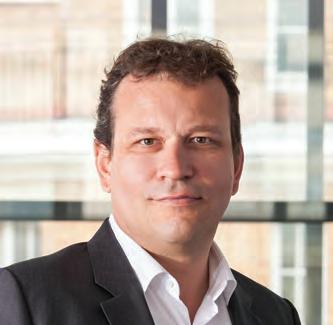
7 minute read
ALTERNATIVE THINKING
US invasion peps up a stale menu of strategies
Euromobiliaire’s Alessandro Angelini says a stream of US entrants into the alternatives market has offered a breath of fresh air and providers are striving to conform to the Ucits format. Chris Sloley reports
If variety is the spice of life, then Euromobiliaire’s Alessandro Angelini may well view the Alt Ucits market as rather dull and unadventurous. The Milan-based fund buyer, who focuses primarily on absolute return strategies, says commonality among European product providers has meant a large number of long/short equity funds in the Alternative Ucits universe have not provided adequate diversification. But thankfully this trend is changing.
‘Five years ago, 90% of managers in the alternatives universe were European, with a low-growth kind of profile and with similar characteristics in terms of style and strategy,’ Angelini says.
‘But in recent years there have been more pure hedge managers entering the market. A lot of US managers are now breaking into the Europe with a Ucits vehicle, which is bringing more sector-specific strategies and more directional funds. This is introducing something different.’
Angelini says this trend is welcome, given the need for increased diversification in allocations.
‘For example, I have one long/short utilities and one long/short tech, and we also have two event-driven funds. A few years ago a lot of this would have been impossible as European managers were mostly similar with plus or minus 20% net and 80-100% gross. We are changing our allocation as a result of these new trends.’
NEW FUNDS, NEW MARKETS Angelini could not be drawn on specific names, but he did indicate that the growth of US companies crossing the Atlantic improves alpha opportunities.
‘This new approach allows us to build portfolios with more potential for alpha from the short side, simply because the universe now comprises pure hedge fund managers rather than long-only managers who happen to have a short book. We can now create portfolios with a higher degree of diversification within underlying funds.’
Angelini adds that, as well as offering a
IDEAS GAP Angelini says finding alternative strategies in the fixed income space is a real challenge. A key roadblock is that interesting US managers are unable to replicate their approaches in a Ucitscompliant format.
‘This is the biggest problem right now in terms of the credit space and fixed income in general, especially in relative value, which suffers from leverage issues,’ he says. ‘If you go to the US, there are many managers in the long/short mould but you cannot do that in Ucits.
‘So, if you take credit long/short, they tend to be short-duration credit with some CDS on the short side, but they are not pure long/short managers. This is the main gap we are seeing.’ more varied exposure, US groups open up an entirely new market.
‘They have spotted the opportunity and realise that if they want to increase their AUM in Europe they will have to launch Alt Ucits.’
Angelini believes there is scope for Asian companies to follow suit, but little progress has been made so far.
‘I know of a couple of event-driven strategies, and some long/short China and one EM, but it is not a big trend.
‘There are some potential problems that would need to be assessed, stemming from the region’s relationship with Ucits and liquidity.
‘There are liquidity constraints and this is a concern for the short side. It is not complex for a quarterly fund but it could be for a daily one,’ he says.
SNAP SHOT
Milan-based Alessandro Angelini has held various roles at Euromobiliare since joining in May 2016. He is currently a portfolio manager with responsibility for absolute return strategies, having previously worked primarily as a fund analyst. Earlier in his career he was a fund of hedge funds analyst at Italian group Anima, as well as having worked at Axa, Old Mutual Wealth and Group BPM Banca Popolare di Milano.
Parisian hedge fund adds another string to its bow
French hedge fund Syquant Capital has outperformed in event-driven equity for over a decade. So, why did the firm branch out into credit? Victoire Barbin Perron finds out
While some may ask ‘if it ain’t broke, why fix it?’, others may counter ‘nothing ventured, nothing gained’. Syquant Capital’s CIO Henri Jeantet opted for the latter notion when the group decided to add to their success in eventdriven equity by trying credit.
Jeantet, who is Citywire AAA-rated, is adamant event-driven credit holds as many intriguing opportunities as equity. This is why he opted to launch the Helium Invest fund – the French firm’s sixth strategy overall – in summer 2019.
The Paris-based investor says this was a logical step as the existing Helium funds exploited elements of the event-driven credit market but this remained marginal in terms of overall contribution to returns. Hence the need for a dedicated vehicle.
Syquant labels the Helium Invest fund as ‘an event-driven credit strategy which will be the main driver in terms of performance and risk’. This may seem slightly vague and Jeantet is reluctant to expand on what has powered the early success of the fund, which has accrued €36m since launch.
‘Helium Invest, like our historic Helium funds, has a well-defined portfolio construction framework. Within this the portfolio manager will select the best riskadjusted returns and build the portfolio with a bottom up approach, so that its exposure will be the sum of all individual positions.’ Jeantet, who co-runs the fund with Philippe Saudreu, is perhaps happy to let performance do the talking, as the wider event-driven equity funds have proven hugely successful.
For example, the Helium Opportunités fund, first launched in 2005 for French investors, has outperformed on a fiveand 10-year basis with returns of 19.5% and 30%, respectively. The Helium fund, launched for European investors, has had similar outperformance.
‘We were very opportunistic,’ Jeantet says, when asked why he expanded beyond equities given the relative success here. ‘This is not a traditional credit fund
but an event-driven credit fund, which means that most of its risk and
its performance is driven by the success of the given event.’ At a time when traditional bond funds are failing to catch fire, Jeantet says there was an opportunity to capitalise on
increasing corporate action, partly prompted by the low cost of capital in the marketplace which has led to more activity. However, he stresses, there is a need not to overreach. The credit fund invests in both investment grade and high yield debt but does not move into distressed debt, so it has nothing in the CCC-rated bucket and rarely strays below B-rated bonds. In addition, the managers can adopt credit hedges where necessary alongside their bottom-up security selection. SHORT TIMEFRAMES Jeantet says: ‘The aim is to minimise credit spread exposure with a short investment horizon, with an average of two to six months in accordance with the event timeframe. The underlying securities will have a short-dated maturity and the duration of the portfolio itself is deemed to be short as well, and below 2.5 years.’ Furthermore, Syquant as a group remains confident about the outlook for the M&A sector, despite an easing off of ‘big ticket’ deals. ‘The cost of capital for M&A still remains in an attractive zone despite some rate rises in the US in recent years,’ Jeantet says. Henri Jeantet, Syquant Capital
‘As soon as clarity returns to the European political scene and the Brexit chapter has been successfully closed, European M&A should be back.’
HITTING THE BULL’S EYE Early signs suggest Jeantet’s ambitious expansion is paying off. Over the seven months the fund was active in 2019, it returned 3.9%, while it has continued into positive territory in 2020. This, Jeantet says, was the result of advantageously exploiting a number of trends including: merger opportunities; early redemptions on senior debt linked to balance sheet restructuring; early redemptions on debt linked to an unnamed corporate action; and capital structure arbitrage.
Where Jeantet will be looking for further advancement is within the size of the strategy. As mentioned, the fund has had a slow uptake in terms of assets, which makes it a relatively minor part of the firm’s overall coverage, given the €3.1bn in assets the company runs as a whole. However, Jeantet is confident this new approach can capture investors’ imaginations, while also building on his hard-won reputation in event-driven investing.






